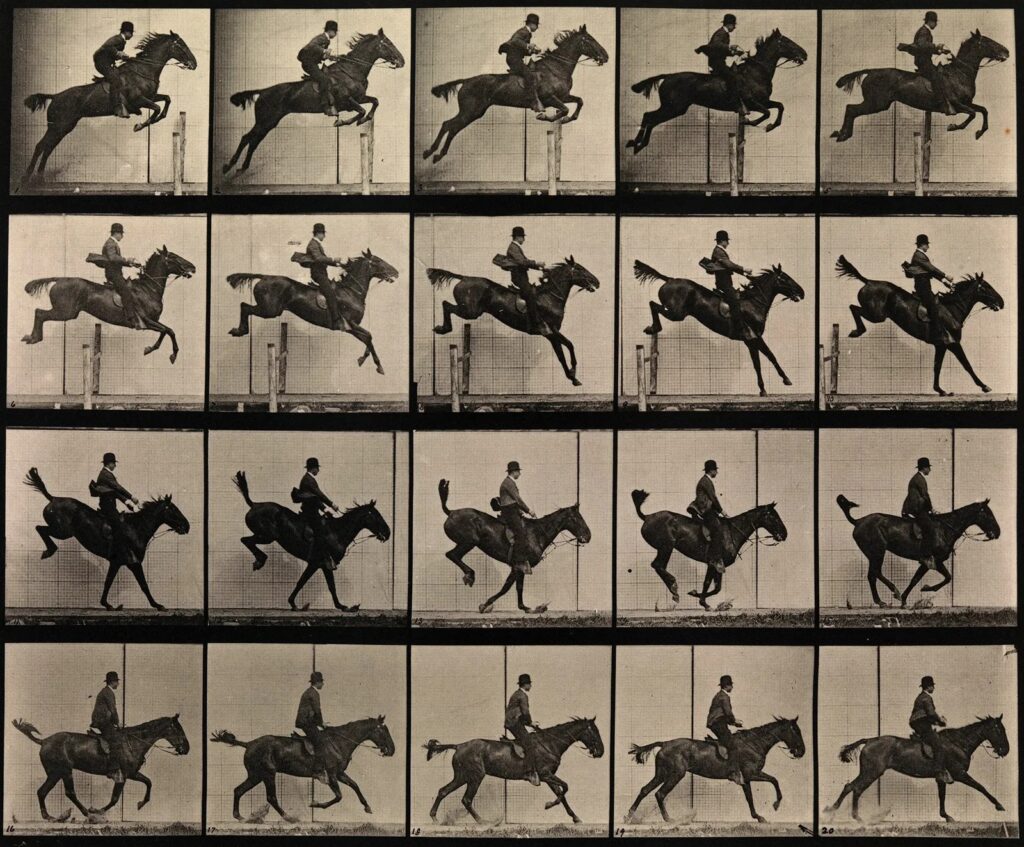What is shutter speed?
Shutter speed is the speed at which the shutter of the camera closes, determining the period during which the sensor is exposed to light. A longer exposure time allows more light to reach the sensor, resulting in a brighter image – controlling and adapting shutter speed is crucial for capturing either sharp images of moving things or exploring creative blurring in moving things.

Fast shutter speed
Fast shutter speeds, at 1/500th of a second or faster, will freeze and capture quick-moving action – so you get a clean image of a subject that would otherwise be blurred.

Slow shutter speed
A slow shutter speed can help you illuminate a darker scene, as it brings more light through the lens. But with a faster shutter speed, the lens is open for a shorter length of time, so less light enters the lens. That makes low light a challenge and demonstrates the importance of a well-lit scene.

Eadweard Muybridge
Muybridge would take his photographic discoveries on tours across America and Europe. During his lifetime he advanced the chemicals that develop film. He quickened camera shutter speed to a fraction of a second. And by aiming dozens of lenses at the same subject, he found ways to stop time and stretch it like elastic.

This is one of Eadweard Muybridge’s work in which he has used fast shutter speed to capture every moment of the horse’s jump.
Harold Edgerton
Edgerton experimented with shutter speed by synchronizing strobe flashes with the motion being examined (for example, the spinning of engine rotors), then taking a series of photos through an open shutter at the rate of many flashes per second, Edgerton invented ultra-high-speed and stop-action photography in 1931.

This piece shows how Edgerton used slow shutter speed to capture the movement of the racket.
Hiroshi Sugimoto
Sugimoto refers to his signature photographic style as “time exposed.” He plays with shutter speeds other photographers struggle to master. His goal with these experiments is, in part, to create time capsules of events and to reveal the paradoxes of time. Sugimoto’s signature style is his use of an 8 x 10 large-format camera combined with extremely long exposure times. This style exemplifies Sugimoto’s mastery of photographic techniques and has contributed to his fame and recognition as an artist.

Sugimoto’s photographs reveal his reverence for technique. They are primarily in black and white, and often made with an analogue large-format camera. These are images made with intent; carefully planned, and often slowly executed. Sugimoto’s work engages with the history of photographic materials and processes.
Francesca Woodman
Woodman used long shutter speed and double exposure when photographing so that she could actively feature in her own work. This also meant that she could capture different stages of movement, in a way that could trace the pattern of time. As a result, her image is blurred, which suggests motion and urgency. Woodman uses long shutter speeds from 1/2 – 5 seconds, as a self portrait photographer this is important and very clever, Woodman uses long shutter speeds to suggest her slow progression through life with a mental illness. as she has long shutter speeds her photographs show the movement of her body (motion blur).


During her career, Woodman produced over 800 black and white photographs. She featured as the subject in many of them, sometimes partially clothed, naked, disguised, hidden or a blur. She used ordinary objects and materials, such as mirrors and pegs, to transform her body parts into distorted and surreal versions.
Effects of changing shutter speed
A slow shutter speed can illuminate a darker scene, as it brings more light through the lens. With a fast shutter speed, the lens is open for less time, so less light can enter. That makes low light a challenge and demonstrates the importance of a well-lit scene. Slower shutter speeds get you blurry lights and motion-blur effects. Think blurry headlights on a highway or artsy light trails. Conversely, faster shutter speeds let you freeze motion with little to no blurriness. Picture an athlete running on a field, perfectly sharp and paused in time. If you’re shooting in lower light, however, faster shutter speeds can require you to increase your ISO which can add unwanted noise or grain to your image.

Class Photoshoot



These are some images from our class photoshoot that is presented in the style of Francesca Woodman, in which we used a slow shutter speed to create almost a ghostly image in black and white.